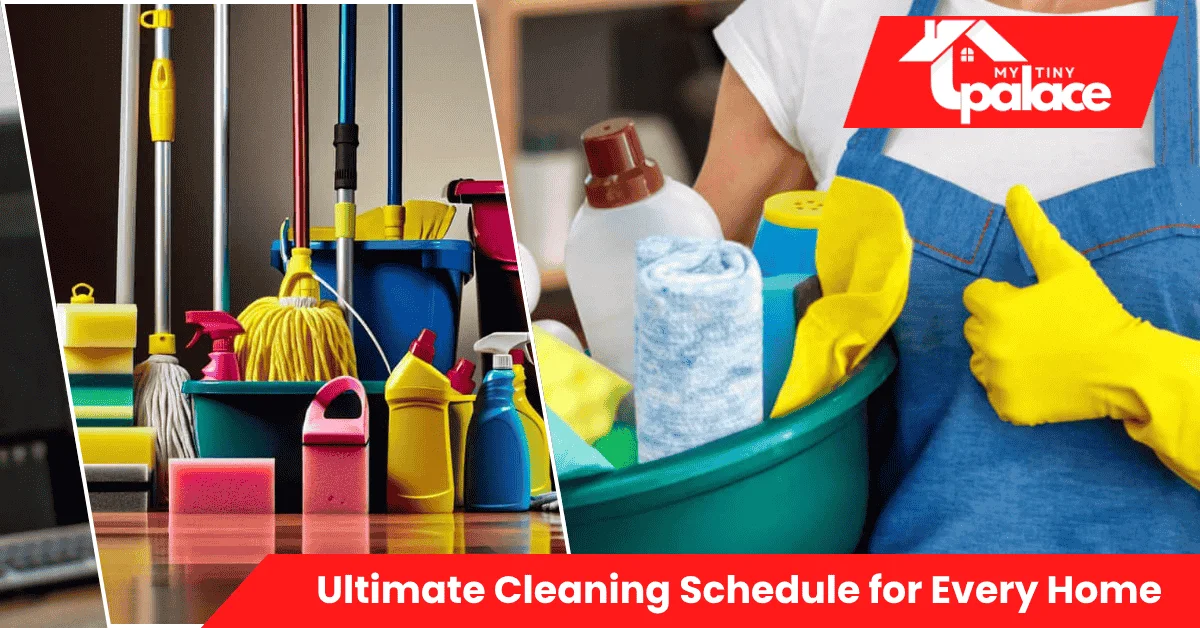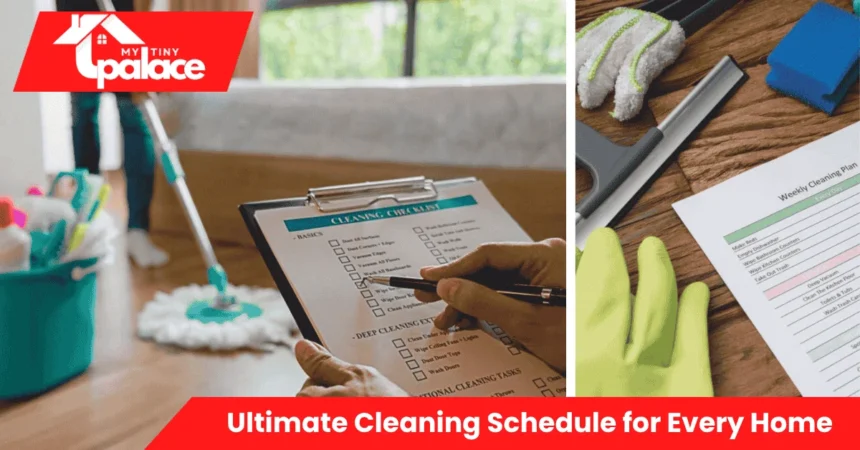Quick summary
Keeping your home clean doesn’t require marathon weekend sessions. This ultimate cleaning schedule breaks tasks into manageable daily, weekly, monthly, and seasonal routines that fit any household. Whether you live alone in a studio apartment or manage a busy family home with pets, this plan scales to your needs and takes just 10 to 30 minutes daily to maintain.
- Quick summary
- Ultimate Cleaning Schedule for Every Home
- Why a cleaning schedule matters for every home
- The core solution: Daily, weekly, monthly, and seasonal plans
- How to tailor the schedule to your home (size, pets, kids, renters)
- Step-by-step: Build your personal cleaning plan
- Tools, supplies, time & cost estimate — include a small table
- Common mistakes & how to avoid them
- Pros & cons / who should consider this schedule
- Quick summary + CTA (what to do next)
Ultimate Cleaning Schedule for Every Home
An ultimate cleaning schedule for every home is a structured plan that divides cleaning tasks across daily, weekly, monthly, and seasonal timeframes. Instead of tackling everything at once, you complete small maintenance tasks regularly and reserve deeper cleaning for longer intervals. This approach prevents overwhelming buildup and keeps your space consistently functional.
The schedule covers routine upkeep like wiping counters and sweeping floors alongside periodic tasks like cleaning oven interiors or washing windows. Daily tasks take 10 to 20 minutes. Weekly cleaning runs 30 minutes to one hour. Monthly deep-cleans need two to three hours. Seasonal projects might consume half a day but happen only quarterly.
The main benefit is consistency without stress. Small regular effort prevents dirt from accumulating to the point where cleaning becomes exhausting. You avoid spending entire weekends scrubbing because you never let messes reach that stage. Your home stays guest-ready with minimal panic cleaning.
This system also improves home health. Regular vacuuming reduces allergens. Consistent bathroom cleaning prevents mold growth. Kitchen maintenance stops bacteria from spreading. These small habits protect your family’s well-being more effectively than occasional intensive cleaning that leaves long gaps where problems develop.
Why a cleaning schedule matters for every home
Following a cleaning routine saves time overall. Wiping your stove after each use takes two minutes. Letting grease build for months requires an hour of scrubbing with harsh chemicals. The same principle applies throughout your home—maintenance prevents difficult restoration work.
A schedule reduces decision fatigue. You don’t waste mental energy each day wondering what needs cleaning. Tuesday means vacuuming. Saturday includes bathroom scrubbing. This automation frees cognitive space for activities you actually enjoy rather than household management anxiety.
Consistent cleaning makes hosting guests stress-free. When your home stays generally tidy, unexpected visitors don’t trigger panic. You might do a quick pick-up; you won’t need emergency deep-cleaning. This readiness creates more spontaneous social opportunities and reduces the isolation many people feel when their homes feel too messy for company.
Property maintenance improves with regular attention. Renters protect security deposits by preventing damage from neglect. Homeowners avoid expensive repairs caused by ignored issues like mold or pest infestations. Landlords appreciate tenants who maintain properties well, potentially leading to lease renewals or positive references.
The mental health benefits matter as much as practical ones. Cluttered, dirty spaces increase stress and reduce focus. Clean environments promote calm and productivity. Maintaining order through small daily actions prevents the overwhelming feeling that comes from facing massive cleaning projects you’ve avoided for weeks.
The core solution: Daily, weekly, monthly, and seasonal plans
Daily maintenance takes 10 to 20 minutes and keeps the baseline order. Make beds each morning. Wipe kitchen counters and the stove after cooking. Sweep or spot-vacuum high-traffic areas. Do dishes or load the dishwasher after meals. Put items back in their designated spots rather than letting clutter accumulate. These small actions prevent chaos from building.
Weekly tasks address areas that need regular attention but not daily care. Vacuum all floors thoroughly, including under furniture when possible. Mop hard floors in kitchens and bathrooms. Clean bathroom sinks, toilets, and showers. Dust surfaces, shelves, and electronics. Change bed linens. Take out all trash and recycling. This routine takes 45 minutes to 90 minutes, depending on home size.
Monthly deep-cleaning targets spots that don’t need frequent attention. Clean inside the refrigerator, removing expired food and wiping shelves. Wipe down cabinet fronts and clean fingerprints from doors and light switches. Vacuum or dust ceiling corners and baseboards. Clean windows and mirrors thoroughly. Wash or replace air filters. Organize one closet or storage area. These tasks require two to three hours total.
Seasonal maintenance happens four times yearly and addresses neglected areas. Clean oven interiors and range hoods. Wash curtains or blinds. Deep-clean grout in bathrooms and kitchens. Vacuum upholstery and under couch cushions. Clean out gutters if you’re a homeowner. Rotate and flip mattresses. These larger projects take three to five hours but happen infrequently enough to schedule around other commitments.

How to tailor the schedule to your home (size, pets, kids, renters)
Small apartments need adjusted frequencies. A 400-square-foot studio requires less vacuuming time than a 2,000-square-foot house. You might vacuum your entire apartment in 10 minutes twice weekly instead of sectioning it across multiple days. Reduce batch sizes but maintain the same task categories.
Pet owners add extra cleaning steps. Vacuum high-traffic areas daily if you have shedding dogs or cats. Clean litter boxes daily and completely change litter weekly. Wipe paws after outdoor walks to prevent tracked mud. Address accidents immediately to prevent stains and odors from setting. Add enzymatic cleaners to your supply kit specifically for pet messes.
Families with young children adjust for higher mess frequency. Spot-clean spills immediately throughout the day. Add toy pickup to your daily routine, ideally teaching kids to participate. Disinfect high-touch surfaces like doorknobs and light switches more frequently during cold and flu season. Accept that perfection isn’t realistic with small children and focus on sanitation over pristine appearance.
Renters prioritize deposit-safe methods. Use removable adhesive hooks instead of nails. Choose gentle cleaners that won’t damage finishes. Document your apartment’s condition when moving in so you’re not blamed for existing damage. Focus heavily on areas landlords inspect closely: kitchens, bathrooms, and carpets. Consider professional carpet cleaning before move-out to ensure the return of your full deposit.
Step-by-step: Build your personal cleaning plan
Start by assessing your actual space and lifestyle. Walk through each room, noting what gets dirtiest fastest. Kitchens used for daily cooking need more frequent attention than guest bedrooms. High-traffic entryways require more sweeping than back hallways. Be honest about your schedule—if you work 60-hour weeks, plan accordingly rather than creating unrealistic expectations.
Prioritize tasks by impact and necessity. Sanitation matters more than aesthetics. Clean toilets and kitchen surfaces where you prepare food before organizing decorative shelves. Tackle visible clutter in common areas before perfecting hidden closets. Focus your limited time on where it affects health and daily function the most.
Slot tasks into your actual available time. Morning people might prefer a 15-minute tidy before work. Night owls may clean after dinner. Block weekly tasks for weekend mornings when you’re fresh. Schedule monthly deep-cleans for three-day weekends or slow work periods. Match cleaning rhythm to your natural energy patterns rather than fighting them.
Test your plan for two weeks, then adjust. Track which tasks you actually complete and which you skip. If you consistently avoid a task, either remove it, reduce its frequency, or swap it to a better time slot. Realistic schedules succeed because they match your life, not an idealized version that doesn’t exist.
4-step quick method
- Assess — Walk your home and list what gets dirtiest fastest in each room
- Prioritize — Rank tasks by health impact and visibility, focusing energy there first
- Slot time — Assign tasks to specific days, matching your natural schedule and energy
- Test & tweak — Try the plan for two weeks, track completion, and adjust what doesn’t work
Tools, supplies, time & cost estimate — include a small table
Essential tools include a vacuum with attachments, microfiber cloths, a quality mop with washable pads, and a scrub brush. Budget versions cost $80 to $120 total and work fine for most homes. Premium tools like robotic vacuums or steam cleaners run $200 to $500 but save time if you use them regularly.
All-purpose cleaning spray handles most surfaces for $4 to $8 per bottle. Specialized products like glass cleaner or wood polish add another $15 to $20 to your initial kit. Microfiber cloths cost $10 for a pack of six and last for years with proper washing. Disposable wipes seem convenient, but cost more over time and create waste.
Time saved matters as much as money spent. A robotic vacuum running daily while you’re at work saves 20 minutes of manual vacuuming weekly. A steam mop cleans and sanitizes simultaneously, eliminating separate mopping and disinfecting steps. Calculate whether time savings justify higher initial costs based on your hourly wage and available free time.
Never mix bleach with ammonia or other cleaners—this creates toxic fumes. Read product labels carefully and use proper ventilation when cleaning with chemicals. Wear gloves to protect skin from harsh cleaners. Store all cleaning supplies away from children and pets in clearly labeled containers.
Quick cost/time table
| Tool/Supply | Estimated Cost | Time Saved Per Week |
|---|---|---|
| Microfiber cloths (reusable) | $10 for 6-pack | 15 min (vs. paper towels) |
| Multi-surface spray | $5–8 per bottle | 10 min (vs. multiple products) |
| Quality vacuum with attachments | $80–300 | 20 min (thorough one-pass cleaning) |
| Robotic vacuum | $200–500 | 2+ hours (autonomous daily cleaning) |
| Steam mop | $50–150 | 20 min (clean + sanitize in one step) |
Common mistakes & how to avoid them
Over-scheduling creates plans you can’t maintain. Start with less than you think you need. You can always add tasks late, but constantly failing at an ambitious schedule destroys motivation. Better ty complete a modest routine than repeatedly abandon an exhaustive one.
Skipping small daily tasks leads to overwhelming weekly sessions. That five-minute dish cleanup prevents hour-long kitchen restoration projects. Daily maintenance is the foundation that makes everything else manageable. Protect these short routines even on busy days.
Using the wrong tools wastes time and damages surfaces. Abrasive scrubbers scratch glass and stainless steel. Harsh chemicals strip protective coatings from appliances. Match your cleaning method to each surface type and read manufacturer care instructions before using new products.
Forgetting maintenance between deep-cleans lets problems return immediately. After organizing a closet, maintain that system by returning items to designated spots. After deep-cleaning grout, wipe tiles after showers to prevent new buildup. One-time projects fail without ongoing upkeep habits.
Pros & cons / who should consider this schedule
This schedule benefits busy professionals who need maximum results from minimum time. Parents managing multiple responsibilities appreciate the predictable structure. Pet owners with higher cleaning demands find the framework adapts well. First-time homeowners or renters building cleaning habits gain a tested starting point.
Some households need professional cleaners for periodic deep work. If mobility issues prevent certain tasks or your schedule truly allows no cleaning time, biweekly or monthly professional service complements your maintenance routine. The schedule then focuses your personal efforts on daily upkeep while pros handle intensive projects.
Trade-offs exist between time and convenience. Following this schedule requires consistent 10 to 20-minute daily commitments. Some people prefer doing nothing on weekdays and spending Saturday cleaning entirely. Neither approach is wrong—choose what matches your preferences and stick with it.
The schedule works best when all household members participate. Dividing tasks among roommates or family members spreads the work. Solo dwellers do everything themselves, but clean smaller spaces. Adjust expectations to match your support system and home size.
Quick summary + CTA (what to do next)
The ultimate cleaning schedule for every home divides tasks across daily, weekly, monthly, and seasonal timeframes so no single session overwhelms you. Small, consistent efforts maintain baseline cleanliness while periodic deep-cleaning prevents long-term buildup. Customize the plan to your household size, pet situation, and schedule realities.
Create your 7-day trial plan today. Write down one daily task, three weekly tasks, and one monthly project. Complete this reduced schedule for one week, noting what works and what needs adjustment. After proving you can maintain this foundation, gradually add tasks until you reach comfortable coverage. Start with just one small daily habit this week.














